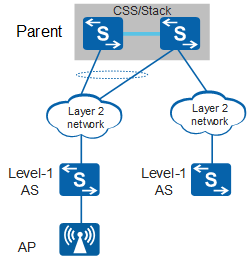1. The parent is directly connected to level-1 ASs.
|

|
Small and medium-sized wired campus networks
|
- Parent
- Create a management VLAN for Layer 2 communication with the client.
- Configure a DHCP address pool to allocate a management IP address to the client.
- Create a CAPWAP source interface for communication with the client.
- Enable the SVF function on the parent.
- Fabric port between the parent and a level-1 AS
- Parent-side fabric port: Manually add a physical member port of the level-1 AS to the fabric port.
- Level-1 AS-side fabric port: Enable the level-1 AS and parent to automatically negotiate a fabric port after the parent-side fabric port is configured.
- Level-1 AS
Change to the client mode.
A switch in client mode has no independent configuration file, and you cannot configure services on it directly. All configurations are delivered to client switches from the parent. If a switch has no configuration file and no input on the console port, it performs auto-negotiation with the parent to change its mode.
Obtain management VLAN information automatically through the parent.
|
2. The parent is directly connected to level-1 ASs, and level-1 ASs are directly connected to APs.
|

|
Small and medium-sized wired and wireless campus networks
|
The configurations of the parent, fabric ports connecting the parent and level-1 ASs, and level-1 ASs are the same as those in networking mode 1.
The AP configuration is the same as that when APs connect to an access controller (AC) and is not described here.
|
3. The parent is directly connected to level-1 ASs, and level-1 ASs are directly connected to level-2 ASs.
|

|
Medium and large-sized wired campus networks
|
The configurations of the parent, fabric ports connecting the parent and level-1 ASs, and level-1 ASs are the same as those in networking mode 1.
Perform the following configuration on the fabric ports between level-1 ASs and level-2 ASs and on level-2 ASs: - Fabric port between a level-1 AS and a level-2 AS
- Level-1 AS-side fabric port: On the parent, manually add a physical member port of the level-2 AS to the fabric port.
- Level-2 AS-side fabric port: Enable the level-2 AS and level-1 AS to automatically negotiate a fabric port.
- Level-2 AS
Change to the client mode.
A switch in client mode has no independent configuration file, and you cannot configure services on it directly. All configurations are delivered to client switches from the parent. If a switch has no configuration file and no input on the console port, it performs auto-negotiation with the parent to change its mode.
Obtain management VLAN information automatically through the parent.
|
4. The parent is directly connected to level-1 ASs, level-1 ASs are directly connected to level-2 ASs, and level-2 ASs are directly connected to APs.
|

|
Medium and large-sized wired and wireless campus networks
|
The configurations of the parent, fabric ports connecting the parent and level-1 ASs, level-1 ASs, fabric ports connecting level-1 ASs and level-2 ASs, and level-2 ASs are the same as those in networking mode 3.
The AP configuration is the same as that when APs connect to an access controller (AC) and is not described here.
|
5. The parent is connected to level-1ASs across a Layer 2 network.
|

|
Networking where there is an intermediate Layer 2 network.
|
|





